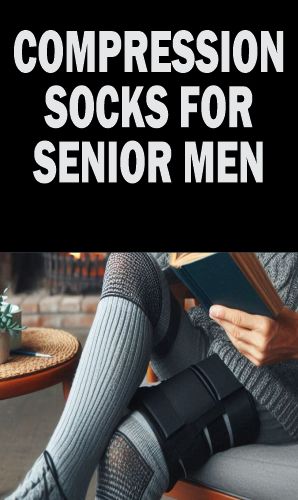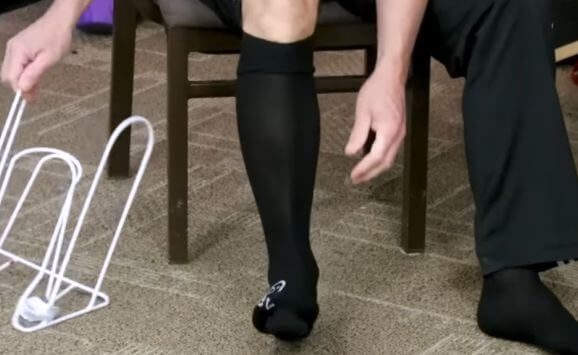Last updated on May 22nd, 2025 at 03:07 am
Discover how to choose the best compression socks for seniors. Learn about key features, benefits, and tips to ensure comfort.
Find out the different compression levels, materials, and brands, as well as tips on selecting the right pair and maintaining their effectiveness through proper care.
Find out how these specialized socks can improve overall leg health and aid in managing conditions like varicose veins and deep vein thrombosis.
AFFILIATE DISCLAIMER!
Some of the links on this website may be affiliate links, meaning we may receive a commission without additional cost to you if you purchase through the links. We only recommend products and services we trust would be beneficial to our readers.
Thank you for your support.
JUMP TO RECOMMENDED COMPRESSION SOCKS FOR OLDER MEN
You might want to pin the image below.

Table of Contents
- What are Compression Socks?
- Medical-Grade Compression Socks for Seniors
- How Medical-Graded Compression Socks Work
- Advantages of Medical Grade Compression Stockings
- Non-Medical Grade Compression Stockings
- Best Compression Socks for Seniors
- Recommended Compressions for Senior Men
- Testimony from Senior Men
- Choosing the Right Compression Socks
- How to Care for and Use Compression Socks
- Putting On and Taking Off Compression Socks
- Cleaning and Storing Compression Socks
- Maximizing Lifespan and Effectiveness
What are Compression Socks?
Compression socks are specialized hosiery designed to provide calibrated pressure on the legs, supporting adequate blood flow and managing swelling and discomfort.
These socks have evolved since their invention, offering a range of pressures and materials tailored to specific needs.
Originally developed for medical use, there are now non-medical compression socks for many reasons.
There are two types of compression socks:
- Medical compression socks and
- Non-medical compression socks
Medical-Grade Compression Socks for Seniors
Medical compression socks are specially designed to apply controlled pressure to the legs, promoting better blood circulation and reducing various leg-related health issues.
While they are often associated with older adults, their benefits extend to a wide range of individuals, particularly older men who may face unique health challenges.
Compression levels in these socks are measured in millimeters of mercury (mmHg), with different levels catering to specific conditions.
The most common levels include mild compression (8-15 mmHg), moderate compression (15-20 mmHg), firm compression (20-30 mmHg), and extra firm compression (30-40 mmHg).
For old men, moderate to firm compression is frequently recommended to alleviate venous insufficiency and varicose veins, and to improve overall leg health.
Related: Habits that Make Older Men to Live Longer
How Medical-Graded Compression Socks Work

The primary mechanism of compression socks is their ability to apply pressure to the veins in the legs.
This pressure helps to:
- Increase Circulation: By squeezing the veins, compression socks improve the flow of blood, which is crucial for older men who may experience reduced circulation due to age-related vascular changes.
- Reduce Swelling: They help reduce the retention of fluid legs, which is particularly beneficial for those suffering from conditions like chronic venous insufficiency (CVI) or edema.
- Prevent Blood Clots: Compression socks are effective in eliminating or reducing the risk of deep vein thrombosis (DVT), especially during long periods of immobility, such as during travel or after surgery.
Recommended: How to Choose Comfy Memory Foam Slippers for Men
Advantages of Medical Grade Compression Stockings
Medical-grade compression stockings have several important benefits compared to regular stockings:
1. Stronger Pressure
Medical-grade compression stockings provide more pressure than non-medical options.
This graduated pressure helps fight against gravity, improving blood flow and stopping blood from collecting in the legs.
As a result, they help reduce the risk of swelling, varicose veins, and other blood circulation problems.
2. Custom Fit
These stockings come in various sizes, lengths, and styles to ensure a good fit for everyone. A better fit means they are more comfortable to wear than standard options, making it more likely that you will wear them regularly.
3. Designed for Specific Health Issues
Medical-grade compression stockings are created with specific health concerns in mind. Doctors or specialists often prescribe them to help with conditions like deep vein thrombosis (DVT), poor blood flow, lymphedema, and leg ulcers.
4. Reliable Quality
Manufacturers of medical-grade compression stockings follow strict quality standards to ensure they work well.
These socks are thoroughly tested for their pressure levels, durability, and comfort. This means they are reliable to provide consistent benefits over time, unlike non-medical stockings, which may not be as reliable.
Plus, they maintain their pressure throughout their use, ensuring they remain effective for a long time.
Related: Tips for Men’s Health after 50
Non-Medical Grade Compression Stockings
Non-medical grade compression stockings, also known as over-the-counter (OTC) compression socks are found in drug stores.
While they might have some compression, they are not medically approved for medical use.
- Lower Pressure Levels: Non-medical grade stockings provide less pressure compared to medical-grade ones, offering mild support suitable for general activities but may not address serious circulation or lymphatic issues effectively.
- General Use: Designed for everyday use, these stockings relieve leg discomfort but lack a customized fit. Frequent use suggests consulting a doctor for potentially more effective medical-grade options.
- Limited Effectiveness: Non-medical-grade stockings offer comfort but may not be as effective as medical-grade stockings, which are specifically designed with precise pressure levels and quality standards for serious conditions.
Related: Adjustable Walking Cane for Older Men
Best Compression Socks for Seniors
1. Physix Gear Sport Compression Socks
Physix Gear Sport Compression Socks are well-known for their exceptional comfort, durability, and performance.
Designed with graduated compression, they help improve blood circulation, reduce leg fatigue, and support muscle recovery, making them ideal for athletes, travelers, and anyone on their feet for extended periods.
These socks are crafted from high-quality, breathable fabric that ensures all-day comfort while maintaining their shape and elasticity over time.
Whether you’re running, working long shifts, or recovering after a workout, Physix Gear Sport Compression Socks deliver reliable support without sacrificing style.
Their sleek design and performance-focused features have made them a popular choice for both men and women.
2. Comrad Compression Socks
Comrad Compression Socks are thoughtfully designed for older men who value both comfort and style.
Offering a high level of graduated compression, they help boost circulation, reduce swelling, and ease leg fatigue, benefits especially important for aging legs.
These socks are ideal for daily wear, whether you’re traveling, staying active, or spending long hours on your feet.
Made from soft, breathable materials, they ensure all-day comfort without compromising on support.
With a variety of colors and modern designs, Comrad Compression Socks let older men stay stylish while caring for their leg health.
They’re a smart, dependable addition to any mature wardrobe.
3. FYTee Compression Socks
FYTee Compression Socks are a great choice for older men seeking reliable support and everyday comfort.
Highly rated for their ease of use, these socks are designed to reduce swelling, improve circulation, and relieve tired, aching legs, common concerns as we age.
Their snug yet comfortable fit makes them easy to put on and wear throughout the day, whether you’re staying active, traveling, or simply relaxing.
Made with soft, breathable materials, FYTee Compression Socks combine functionality with comfort, making them ideal for daily wear.
Their effective support and simple design make them a dependable addition to any older man’s health-conscious wardrobe.
Recommended Compressions for Senior Men
1. Easy on compression socks for seniors
Easy-on compression socks for seniors are designed to provide the benefits of traditional compression socks with added convenience for those with limited mobility or dexterity.
These socks feature flexible materials, wider openings, and special design elements like zippers or stretchy fabric to simplify the wearing process.
The graduated compression helps improve circulation, reduce swelling, and alleviate discomfort, crucial for seniors who may suffer from poor circulation or varicose veins.
The easy-on design ensures that seniors can put on and take off their socks with minimal effort, enhancing their independence and comfort.
By combining effective compression therapy with user-friendly features, these socks offer practical support and ease of use for older adults.
2. Zipper Compression Socks for Seniors
Zipper compression socks for seniors combine the benefits of compression therapy with ease of use through a convenient zipper closure.
Designed for those with limited mobility or dexterity, these socks feature a side zipper that allows for effortless wearing and removal, eliminating the struggle often associated with traditional compression socks.
The compression still provides essential support by improving circulation, reducing swelling, and easing leg discomfort.
Zipper compression socks come in various compression levels to suit different medical needs and preferences.
Their design ensures that seniors receive the therapeutic benefits of compression therapy without the hassle, enhancing their comfort and independence.
These socks are ideal for seniors who require both effective leg support and a simplified dressing process.
Testimony from Senior Men
Many older men have shared personal anecdotes about how compression socks have transformed their daily lives. John, a 72-year-old retiree, mentions, “Wearing compression socks daily has significantly reduced the swelling in my legs and improved my mobility.
I feel more active and less fatigued.” Such testimonials highlight the practical, day-to-day advantages these socks provide, confirming their effectiveness beyond clinical settings.
Choosing the Right Compression Socks
Selecting the proper compression socks is paramount to ensure their effectiveness and comfort. The first step is determining the correct size.
Size
Accurate measurements of the ankle, calf, and sometimes the thigh are crucial.
Most brands provide sizing charts to help match your measurements with the appropriate size of socks.
A misfit can defeat the purpose of wearing compression socks, either by providing insufficient compression or causing discomfort.
Compression Level
The next consideration is the compression level. Compression socks are categorized by the amount of pressure they exert, measured in millimeters of mercury (mmHg).
For everyday wear and light support, a lower compression level, such as 15-20 mmHg, is often sufficient.
For more specific medical needs, such as managing varicose veins or severe swelling, higher compression levels like 20-30 mmHg or 30-40 mmHg might be necessary.
Consulting with a healthcare provider is advisable, especially for those with preexisting medical conditions.
Material
Choosing the right compression socks involves selecting materials like cotton, nylon, or spandex blends that enhance comfort, breathability, and durability.
For older men, comfort and longevity are essential. Individuals with certain medical conditions should consult a healthcare provider before use.
Various brands, such as Sigvaris and Jobst, offer options tailored for different needs, including specialized features for added comfort and health benefits.
How to Care for and Use Compression Socks
Proper care and use of compression socks are essential to ensuring their longevity and effectiveness, particularly for older men who rely on them for improved circulation and reduced leg fatigue.
Below are practical steps for maintaining compression socks, from donning and doffing to cleaning and storage.
Putting On and Taking Off Compression Socks
For optimal benefits, it is important to correctly wear compression socks.
Here’s a step-by-step guide:
- Begin by turning the sock inside out up to the heel.
- Insert your foot into the sock, ensuring your heel fits snugly into the heel pocket.
- Gradually roll or slide the sock up your leg, smoothing out any wrinkles to ensure even compression.
- Remove the socks by gently rolling them down from the top without excessive stretching or pulling, which can damage the fabric.
Cleaning and Storing Compression Socks
To maintain their elasticity and functionality, compression socks require regular cleaning after each use:
- Hand wash or machine wash on a gentle cycle using a mild detergent. Avoid using bleach or fabric softeners as these can degrade the material.
- Rinse thoroughly to remove any detergent residue.
- Lay flat or hang to air dry. Avoid direct sunlight or high heat to prevent material breakdown.
Maximizing Lifespan and Effectiveness
To extend the life of your compression socks, it’s important to follow some additional maintenance tips:
- Rotate between several pairs to avoid overuse and frequent washing of a single pair.
- Inspect your socks regularly for signs of wear, such as thinning fabric or loss of elasticity, and replace as needed.
- Follow the manufacturer’s guidelines on wearing duration. Generally, compression socks can be worn throughout the day but should be removed before bedtime unless otherwise advised by a healthcare professional.
References:
- https://vanishlegveins.com/medical-grade-vs-non-medical-grade-compression-stockings-which-are-better-for-me
- https://www.pebbleuk.com/categories/25/medical-compression-stockings
- https://www.youtube.com/watch?v=OjpjzMqTO_g
Pyo Merez is a men’s lifestyle enthusiast and writer about the gentleman’s place and impact on society. Raised by a distinguished gentleman dad, he offers unique insights into how the mind of a gentleman works and how societal norms shape gentlemen’s identity and vice versa.
Through his insightful articles, Pyo taps into the depths of gentleman culture to provide perspectives on etiquette and manners in modern society.

